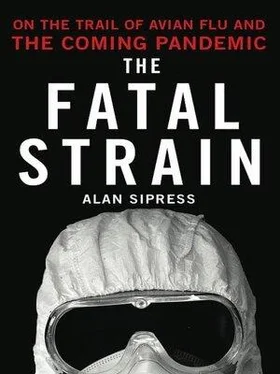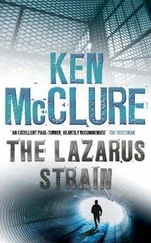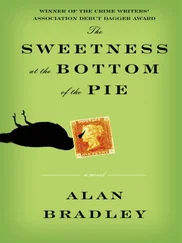127 more of the story:The cluster is also described in Kumnuan Ungchusak et al., “Probable Person-to-Person Transmission of Influenza A (H5N1),” NEJM 352, no. 4 (Jan. 27, 2005): 333-40; and “Excerpts of the Meeting of the Expert Panel on Avian Influenza,” Bangkok, Sept. 27, 2004.
130 Thailand’s health ministry announced:“Avian Influenza Infection of Patients in Kamphaeng Phet,” press release, Ministry of Health, Thailand, Sept. 28, 2004.
130 WHO released a statement:WHO, “Avian Influenza—Situation in Thailand,” Sept. 28, 2004.
130 But even as they accepted:Likely cases of human transmission have occurred in at least a half-dozen countries, also including Indonesia, Cambodia, Pakistan, and China. On the last, for example, see Hua Wang et al., “Probable Limited Person-to-Person Transmission of Highly Pathogenic Avian Influenza A (H5N1) Virus in China,” Lancet 371, no. 9622 (April 26, 2008): 1427-34.
Chapter Five: Livestock Revolution
This chapter draws on interviews with dozens of villagers in Suphan Buri Province.
133 another continent in the 1950s:Interview with local historian Samreong Reaungrit.
134 chicken made its debut:For the history of the chicken industry in Thailand, see Christopher L. Delgado, Clare A. Narrod, and Marites M. Tiongco, Policy, Technical, and Environmental Determinants and Implications of the Scaling-Up of Livestock Production in Four Fast-Growing Developing Countries: A Synthesis, Final Research Report of Phase II, International Food Policy Research Institute, June 23, 2003, ch. 2.2; Christopher L. Delgado and Clare A. Narrod, Impact of Changing Market Forces and Policies on Structural Change in the Livestock Industries of Selected Fast-Growing Developing Countries, Final Research Report of Phase I, International Food Policy Research Institute, June 28, 2002, chapter 4.5; and Nipon Poapongsakorn et al., “Annex IV: Livestock Industrialization Project: Phase II—Policy, Technical, and Environmental Determinants and Implications of the Scaling-Up of Swine, Broiler, Layer and Milk Production in Thailand,” July 25, 2003, included in Delgado, Narrod, and Tiongco, Policy, Technical, and Environmental Determinants, 2003.
134 doubled the average amount of chicken:Nipon Poapongsakorn et al., “Annex VIII: Livestock Industrialization, Trade and Social-Health-Environment Issues for the Thai Poultry, Dairy, and Swine Sector,” May 2002, included in Delgado and Narrod, Impact of Changing Market Forces, 2002.
134 an even cheaper source of protein:Ibid.
135 soaring demand for eggs:Thailand’s egg consumption doubled in a decade. Delgado, Narrod, and Tiongco, Policy, Technical, and Environmental Determinants, ch. 2.2.
137 the first to fall sick:Jared Diamond, Guns, Germs, and Steel (New York: W. W. Norton, 1997), 92.
137 afflicting their livestock:Ibid., 196-97.
137 evolved from animal pathogens:Jared Diamond, “Evolution, Consequences and Future of Plant and Animal Domestication,” Nature 418 (Aug. 8, 2002): 700-707.
137 about 60 percent also cause disease in animals:S. Cleaveland, M. K. Laurenson, and L. H. Taylor, “Diseases of Humans and Their Domestic Mammals: Pathogen Characteristics, Host Range and Risk of Emergence,” Philosophical Transactions of the Royal Society of London B: Biological Sciences 356, no. 1411 (July 29, 2001): 991-99.
137 These microbes can hopscotch:Willam B. Karesh and Robert A. Cook, “The Human-Animal Link,” Foreign Affairs, July-Aug. 2005.
137 An even higher proportion:L. H. Taylor, S. M. Latham, and M. E. Wool-house, “Risk Factors for Human Disease Emergence,” Philosophical Transactions of the Royal Society of London B: Biological Sciences 356, no. 1411 (July 29, 2001): 983-89.
137 “Similar to the time”:“Animal Health at the Crossroads: Preventing, Detecting, and Diagnosing Animal Diseases” (Washington: National Academy of Sciences, 2005), 27.
137 a mystery illness erupted:For an account, see Keith B. Richburg, “Malaysia Slow to Act on Virus,” Washington Post, Apr. 29, 1999.
138 opening of trade routes:See, for example, William H. McNeill, Plagues and Peoples (New York: Anchor Books, 1998); Wu Lien-Teh et al., Plague: A Manual for Medical and Public Health Workers (Shanghai: National Quarantine Service, 1936); and John Kelly, The Great Mortality (New York: HarperCollins, 2005).
138 “Pharoah’s rats”:Wu Lien-Teh et al., Plague. I learned of this reference in Kelly, Great Mortality.
138 plague erupted in southern China:For a good account of the Yunnan outbreak and the subsequent spread of the disease, see Carol Benedict, Bubonic Plague in Nineteenth-Century China (Stanford, CA: Stanford University Press, 1996).
139 it ravaged Hong Kong:For accounts, see Benedict, Bubonic Plague; and Edward Marriott, The Plague Race: A Tale of Fear, Science and Heroism (New York: Picador, 2003).
139 “Little wonder, then”:Marriott, Plague Race, 52.
139 reported that patients suffered:James Cantlie, “The First Recorded Appearance of the Modern Influenza Epidemic,” British Medical Journal 2 (1891): 491.
140 “epicenter” of all influenza viruses:Kennedy F. Shortridge and C. H. Stuart-Harris, “An Influenza Epicentre?” Lancet 2 no. 8302 (Oct. 9, 1982): 812-13; and Kennedy F. Shortridge, “Is China an Influenza Epicenter?” Chinese Medical Journal 110 no. 8 (1997): 637-41. More recently, researchers who studied the global spread of seasonal H3N2 flu strains between 2002 and 2007 have also suggested that the region of East and Southeast Asia is the annual source of the world’s seasonal flu viruses. See Colin A. Russell et al., “The Global Circulation of Seasonal Influenza A (H3N2) Viruses,” Science 320, no. 5874 (Apr. 18, 2008): 340-46.
140 aquatic birds:Robert G. Webster et al., “Evolution and Ecology of Influenza A Viruses,” Microbiological Review 56, no. 1 (Mar. 1992): 152-79.
140 actually been isolated earlier:A picture of the Chinese scientist who Shortridge says first isolated the 1957 Asian flu virus is shown in Kennedy F. Shortridge, “Influenza—a Continuing Detective Story,” Lancet 354 (1999): suppl. SIV 29.
141 matter of greater dispute:For a broader examination of competing hypotheses, see Gina Kolata, Flu: The Story of the Great Influenza Pandemic of 1918 and the Search for the Virus that Caused It (New York: Simon & Schuster, 1999), ch. 10.
141 Haskell County, Kansas:John M. Barry, “The Site of the Origin of the 1918 Influenza Pandemic and Its Health Implications,” Journal of Translational Medicine 2 (Jan. 20, 2004): 3. Among the evidence cited by Barry against an Asian or European provenance is Edwin O. Jordan, Epidemic Influenza: A Survey (Chi cago: American Medical Association, 1927). Jordan concluded, “The primary origin of the 1918 pandemic cannot be traced with any degree of plausibility to any one of these localized outbreaks,” referring to India, China, Japan, France, Germany, or the military camps of the United States and Britain. Jordan himself could not pinpoint the origin.
141 British army camp:J. S. Oxford, “The So-called Great Spanish Influenza Pandemic of 1918 May Have Originated in France in 1916,” Philosophical Transactions of the Royal Society of London B: Biological Sciences 356 (2001): 1857-59.
Читать дальше











